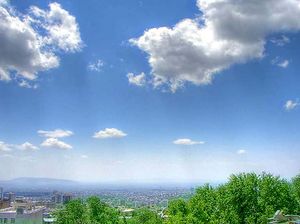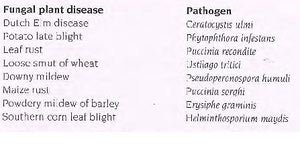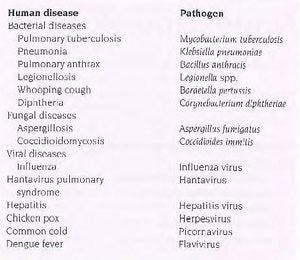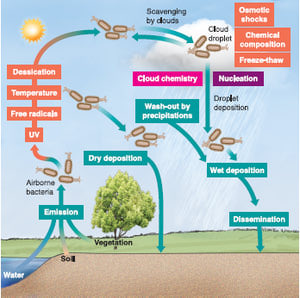Aeromicrobiology: Difference between revisions
(→Clouds) |
(→Clouds) |
||
| Line 12: | Line 12: | ||
===Clouds=== | ===Clouds=== | ||
One area that bioaerosols can be found in is within clouds. Cloud water is a mixture of organic and inorganic compounds suspended within moisture (contribution of microbial activity yo clouds). The conditions in clouds are not conducive to much life, as microbes present there must withstand freezing temperatures, the threat of desiccation, and extreme UV rays. Clouds are also an acidic environment, with a pH ranging from 3 to 7. Nevertheless, there are extremophile microbes which can withstand all of these environmental pressures. Clouds serve as a transport for these microbes, dispersing them over long distances | One area that bioaerosols can be found in is within clouds. Cloud water is a mixture of organic and inorganic compounds suspended within moisture (contribution of microbial activity yo clouds). The conditions in clouds are not conducive to much life, as microbes present there must withstand freezing temperatures, the threat of desiccation, and extreme UV rays. Clouds are also an acidic environment, with a pH ranging from 3 to 7. Nevertheless, there are extremophile microbes which can withstand all of these environmental pressures. Clouds serve as a transport for these microbes, dispersing them over long distances (Amato 2012). | ||
[[Image:clouds.jpg|thumb|300px|right|Microbes exist within the atmosphere, and can be transported within clouds. Photo by Hamed Saber/flickr/Creative Commons.]] | [[Image:clouds.jpg|thumb|300px|right|Microbes exist within the atmosphere, and can be transported within clouds. Photo by Hamed Saber/flickr/Creative Commons.]] | ||
Revision as of 04:08, 17 April 2012
Aeromicrobiology
Introduction
Aeromicrobiology is the study of living microbes which are suspended in the air. These microbes are referred to as bioaerosols (Brandl et. Al, 2008). Though there are significantly less atmospheric microorganisms than there are in oceans and in soil, there is still a large enough number that they can affect the atmosphere (Amato, 2012). Once suspended in the air column, these microbes have the opportunity to travel long distances with the help of wind and precipitation, increasing the occurrence of widespread disease by these microorganisms. These aerosols are ecologically significant because they can be associated with disease in humans, animals and plants. Typically microbes will be suspended in clouds, where they are able to perform processes that alter the chemical composition of the cloud, and may even induce precipitation (Amato 2012).
Physical Environment
Atmosphere
Along with water droplets, dust particles and other matter, air contains microbes (Al-Dagal 1990). Microbes follow a particular pathway in which they are suspended into the atmosphere. First they are launched into the air. The source of the launching of airborne microbes stems from humans, animals and vegetation. (Al-Dagal 1990). then they are transported (by various methods including winds, machinery and people) and finally are deposited somewhere new. The atmosphere can have a variety of physical characteristics, and can be very extreme in terms of the relative humidity, temperature and radiation. These factors play a huge role in what kinds of microbes will survive in the atmosphere and how long they will stay alive. (Pepper 2011)
Clouds
One area that bioaerosols can be found in is within clouds. Cloud water is a mixture of organic and inorganic compounds suspended within moisture (contribution of microbial activity yo clouds). The conditions in clouds are not conducive to much life, as microbes present there must withstand freezing temperatures, the threat of desiccation, and extreme UV rays. Clouds are also an acidic environment, with a pH ranging from 3 to 7. Nevertheless, there are extremophile microbes which can withstand all of these environmental pressures. Clouds serve as a transport for these microbes, dispersing them over long distances (Amato 2012).
Microbial Communities
Many different microorganisms can be in aerosol form in the atmosphere, including viruses, bacteria, fungi, yeasts and protozoans. In order to survive in the atmosphere, it is important that these microbes adapt to some of the harsh climatic characteristics of the exterior world, including temperature, gasses and humidity. Many of the microbes that are capable of surviving harsh conditions can readily form endospores, which can withstand extreme conditions (Al-Dagal 336).
Many of these microorganisms can be associated with specific and commonly known diseases. Below are two tables. Table 1 below shows examples of Airborne Plant pathogens, and Table 2 shows examples of airborne human pathogens.
Microbial Processes
“Microbes are emitted from surfaces (water, soil, vegetation), get airborne and transported upward by turbulent fluxes. They are subject to environmental conditions (indicated in red boxes) in the atmosphere that likely filter for the more resistant of them. In cloud droplets, viable microorganisms can participate to the degradation of organic compounds, and some species can nucleate freezing, and, in theory, induce precipitations. They are finally wet deposited and in a position for colonizing new environments (Amato 2012).”
Current Research
Studies about bioaerosols are difficult to conduct because identifying specific microbes and fungi in the air is a daunting task. One study conducted by Mark Hayes and associated looked into the feasibility of identifying specific particles in the air using fingerprinting techniques. It discussed sampling and analysis techniques that can help to identify cellular material. This is important because the particles in the air are information rich and can tell us a lot about where they originated or certain biochemical information about the organisms (Hayes 2012).
A great deal of the research conducted on bioaerosols studies their effects on humans, since human disease is one of the effects of bioaerosols. One such study conducted by Brandl and associates studied the distribution and dynamics of particles within the air in a lecture hall. Knowing what is in the air is important as human mortality rates increase with the rise of airborne particulate populations (Brandl 2008). Additionally, people are continually spending more time indoors, and knowing what exists within the air they breathe is important. This study found that bioaerosol populations were highest when there were a great deal of students in the hallways and the lecture area, proving that humans are a vector for the transport of bioaerosols.
Another study conducted this year by Vinni Hansen looked into components in both greenhouses and open fields to see which affected the levels of fungal bioaerosols. This study was conducted primarily to determine which is more detrimental to farmworkers. The study concluded that the bioaerosol levels were related to the environment, the work tasks, and the vegetable crops.
References
al-Dagal, M., & Fung, D. Y. (1990). Aeromicrobiology--a review. Critical Reviews in Food Science and Nutrition, 29(5), 333-340. Retrieved from www.scopus.com
Amato, Pierre. "Clouds Provide Atmospheric Oases for Microbes." Microbe Magazine: n. pag. American Society for Microbiology. Web. 1 Apr. 2012. <http://www.microbemagazine.org/index.php/02-2012-home/4547-clouds-provide-atmospheric-oases-for-microbes>.
Brandl, Helmut, et al. "Short-Term Dynamic Patterns of Bioaerosol Generation and Displacement in an Indoor Environment." International Journal of Aerobiology (Oct. 2008): n. pag. Academic Search Premier. Web. 1 Apr. 2012.
Mark Hayes, et al. "Exploring The Feasibility Of Bioaerosol Analysis As A Novel Fingerprinting Technique." Analytical & Bioanalytical Chemistry 403.1 (2012): 15-26. Academic Search Premier. Web. 10 Apr. 2012.
Madsen, Anne Mette et al. "Factors Affecting Vegetable Growers’ Exposure To Fungal Bioaerosols And Airborne Dust." Annals Of Occupational Hygiene 56.2 (2012): 170-181. Academic Search Premier. Web. 10 Apr. 2012.
Pepper, Ian L., and Scot E. Dowd. "Aeromicrobiology." Environmental Microbiology. N.p.: Academic Press, 2009. 83-101. Print.
Saber, Hamed. Clouds. August 22, 2011. "The Long Strange Journey of Earth's Microbes." Matte Network. Web. 10 Apr. 2012. <http://featured.matternetwork.com/2011/8/long-strange-journey-earths-traveling.cfm>.




